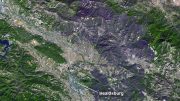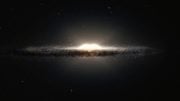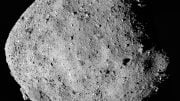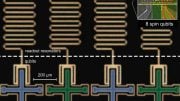A new ScienceCast video answers the question, what does interstellar space sound like?
As Voyager 1 recedes from the solar system, researchers are listening for “interstellar music” (a.k.a. plasma waves) to learn more about conditions outside the heliosphere.
Sci-Fi movies are sometimes criticized when explosions in the void make noise. As the old saying goes, “In space, no one can hear you scream.” Without air there is no sound.
But if that’s true, what was space physicist Don Gurnett talking about when he stated at a NASA press conference in September 2013 that he had heard “the sounds of interstellar space?”
It turns out that space can make music … if you know how to listen.
Gurnett is the James Van Allen professor of physics at the University of Iowa and the principal investigator for the Plasma Wave Science instrument on Voyager 1. At the press conference, he played some plasma wave data for the audience. The sounds, he explained, were solid evidence that Voyager 1 had left the heliosphere.
The heliosphere is a vast bubble of magnetism that surrounds the sun and planets. It is, essentially, the sun’s magnetic field inflated to enormous proportions by the solar wind. Inside the heliosphere is “home.” Outside lies interstellar space, the realm of the stars.
For decades, researchers have been on the edge of their seats, waiting for the Voyager probes to leave. Ironically, it took almost a year for NASA to realize the breakthrough had occurred. The reason is due to the slow cadence of transmissions from the distant spacecraft. Data stored on old-fashioned tape recorders are played back at three to six-month intervals. Then it takes more time to process the readings.
Gurnett recalls the thrill of discovery when some months-old data from the Plasma Wave Instrument reached his desk in the summer of 2013. The distant tones were conclusive: “Voyager 1 had made the crossing.”
Strictly speaking, the plasma wave instrument does not detect sound. Instead, it senses waves of electrons in the ionized gas or “plasma” that Voyager travels through. No human ear could hear these plasma waves. Nevertheless, because they occur at audio frequencies, between a few hundred and a few thousand hertz, “we can play the data through a loudspeaker and listen,” says Gurnett. “The pitch and frequency tell us about the density of gas surrounding the spacecraft.”
This animation combines two ways of displaying the Voyager Plasma Wave Science (PWS) observations of electron plasma oscillations which provide the basis for concluding that the spacecraft is now in interstellar space. The graphic is called a spectrogram that shows the amplitude of waves (in which reds are the most intense and blues the least intense) as a function of frequency (vertical axis) and time (horizontal axis). In many respects, this spectrogram is like a voice print which shows the evolution of the spectrum of sounds as a function of time. The sound track reproduces the amplitude and frequency of the plasma waves observed. The vertical white bar that moves across the spectrogram links the sound track to the graphic.
The frequency range shown from about 1.75 kiloHertz to 3.5 kiloHertz is a portion of the actual frequency range detected by PWS and is well within the audio frequency range. Importantly, the frequency is directly related to the number of electrons per unit volume in the vicinity of Voyager and corresponds to about 1 electron per 10 cubic centimeters or a cube about 1 inch on a side. The time scale for this presentation represents 225 days or a bit more than 7 months, while it only takes about 12 seconds to play the audio file. Hence, the time compression is about 1.6 million to one. It should be noted that this compression was done in such a way as to not change the frequencies.
In this animation, there are two events of interest. In the October-November 2012 time frame there is a tone near 2.1 kHz which gradually increases in frequency. Again, in the April-May 2013 time frame there is another event, somewhat more intense and at a higher frequency near 2.6 kHz. We conclude that these two events indicate an ongoing trend to higher frequencies. The second graphic frame which appears in the animation includes a dashed line showing this increase in frequency and suggests that the density of electrons is continually increasing over this time interval as Voyager moves outwards from the heliopause (which was crossed on 25 August 2012).
When Voyager 1 was inside the heliosphere, the tones were low, around 300 Hz, typical of plasma waves coursing through the rarified solar wind. Outside, the frequency jumped to a higher pitch, between 2 and 3 kHz, corresponding to denser gas in the interstellar medium. The transition music to Gurnett’s ears.
So far, Voyager 1 has recorded two outbursts of “interstellar plasma music”–one in Oct-Nov. 2012 and a second in April-May 2013. Both were excited by bursts of solar activity.
“We need solar events to trigger plasma oscillations,” says Gurnett.
The key players are CMEs, hot clouds of gas that blast into space when solar magnetic fields erupt. A typical CME takes 2 or 3 days to reach Earth, and a full year or more to reach Voyager. When a CME passes through the plasma, it excites oscillations akin to fingers strumming the strings on a guitar. Voyager’s Plasma Wave Instrument listens … and learns.
“We’re in a totally unexplored region of space,” says Gurnett. “I expect some surprises out there.”
In particular, Gurnett is hoping for plasma waves not excited by solar storms. He speculates that shock fronts from outside the solar system could be rippling through the interstellar medium. If so, they would excite new plasma waves that Voyager 1 will encounter as it plunges ever deeper into the realm of the stars.
The next “sounds” from out there could be surprising indeed.
Image: NASA/JPL-Caltech









It seems to me now would be a better chance to hear a signal transmission from ET, I hope someone is not just thinking the Noise is “Sounds of Interstellar Space” ! 2, 3, 5, 7, 11, 13, 17, 19, 23, 29, 31, 37, 41, 43, 47, 53, 59, 61, 67, 71, 73, 79, 83, 89……
Please note that “We need solar events to trigger plasma oscillations,”.. Here in this case the plasma oscillations are manipulated to give the sound effect as it videographs (or rather audiographs) the voyager 1 travel beyond Pluto in the rarefied solar particles field where the magnetic bursts from the Sun gives this electronic impulses, magnified to be heard as sound. But be sure that ET cannot give signal transmission to be felt. The so called signal transmission by ET was found to be none other than Cosmic Microwave Backround, which is the Doppler attenuation of Big Bang gamma radiations suffered due to the galloping galaxies. After such a long period the voyager has not completely left solar gravity zone since there is a Kuiper cloud still there with streaming asteroids and comets racing towards the Sun. Once it leaves solar gravity completely it will go towards the nearest star no doubt, which will also have the same complexion like ours.Thank You.